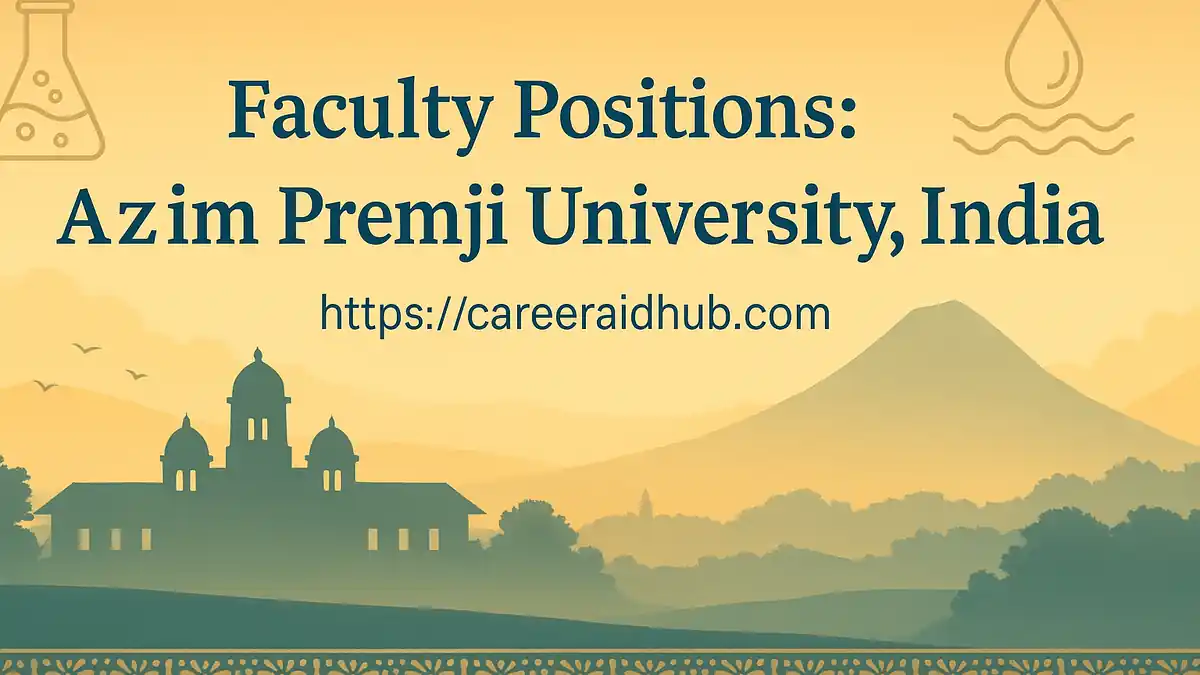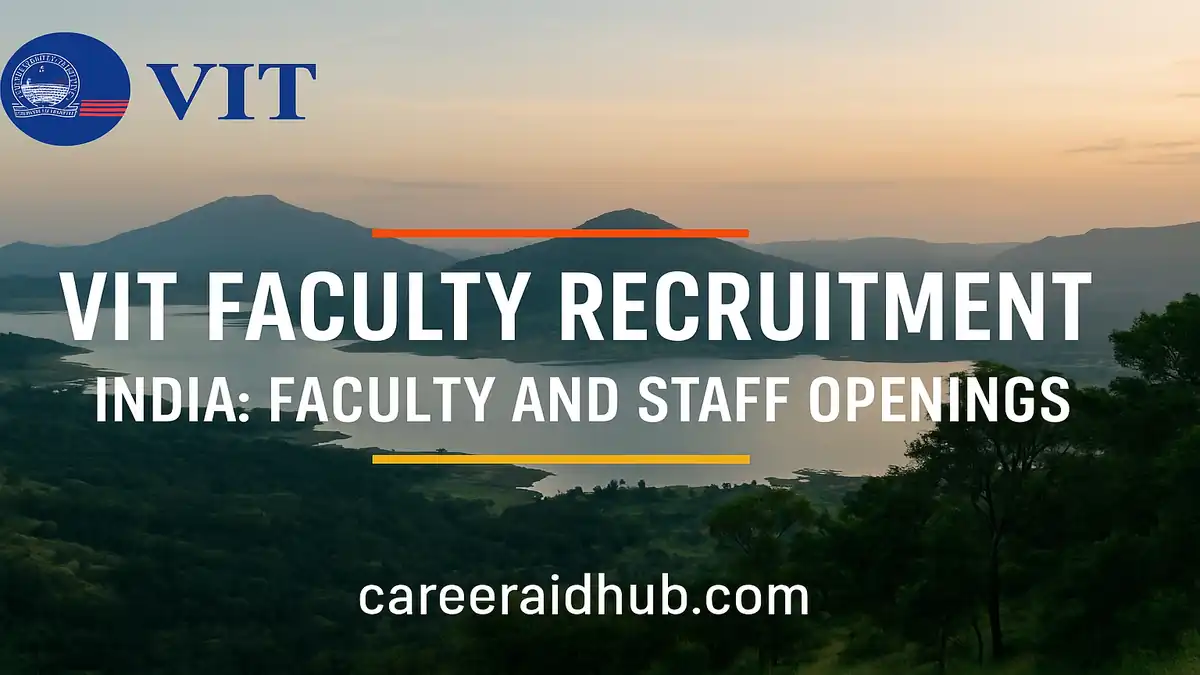Ashoka University invites exceptional scholars and higher-education professionals to contribute to a distinctive liberal arts and sciences community in the National Capital Region. Most academic searches route through Interfolio, while department pages announce calls and point candidates to the official portal for submission—ensuring a single source of truth for requirements and timelines.
Join Ashoka University’s vibrant liberal arts and sciences ecosystem in India’s National Capital Region. Explore open faculty and academic roles managed through Interfolio, with departments posting discipline-specific calls and clear instructions. Prepare a strong dossier and track seasonal refreshes to target the right opportunity at the right time.
Why Consider Ashoka University?
Ashoka blends rigorous disciplinary depth with genuine interdisciplinarity. Faculty and academic staff collaborate across schools and centres, regularly co-designing courses and labs that reflect real-world problems instead of narrow silos. Because the academic portfolio spans humanities, social sciences, natural sciences, and computing, you can supervise across levels and combine methods—quantitative, qualitative, experimental—within the same project.
Scholarly Ecosystem and Research Enablement
A growing constellation of research centres supports grant acquisition, partnerships, and outreach. Consequently, prototypes can move beyond the classroom into field studies, policy pilots, or industry proof-of-concepts. Administrative teams streamline processes for ethics approvals, collaborations, and events, so your time remains focused on research and teaching
Teaching Philosophy and Student Experience
Undergraduate and graduate curricula emphasise project-based learning, studio-style delivery, and writing-intensive coursework. As a result, students bring strong analytical and communication skills to lab groups, capstones, and internships, which in turn accelerates faculty research agendas.
A Culture of Collaboration
On campus, teams routinely bridge methods and domains: computational tools for public policy, ethics frameworks for AI, environmental data for history and sociology, and design thinking in the sciences. Collaboration is deliberate, not incidental. Programmes budget shared resources and align timetables to make team-taught courses and cross-listed seminars practical. In addition, annual workshops and reading groups help colleagues test ideas and assemble multi-investigator proposals.
Where to Find the Latest Openings
Ashoka lists open roles across two official streams:
- Faculty and academic positions announced by departments/centres, which route applications through Interfolio. Department pages describe area priorities and direct applicants to the live Interfolio listing for materials and instructions.
- Institutional careers portals carrying academic, postdoctoral, and research staff roles. These pages refresh on a rolling basis and complement Interfolio postings with filters by department and job type.
Tip: Bookmark the Interfolio positions hub and the careers portal. Departments
What Types of Roles Are Advertised?
Ashoka runs searches across ranks and appointment types, reflecting sustained growth:
- Tenure-track and tenured faculty in areas such as Computer Science, Economics, Psychology, Chemistry, and others. Some calls are open-rank; others specify priority subfields.
- Visiting and fixed-term faculty, including open-rank visiting calls in the social sciences and humanities aligned to course coverage and collaborative projects.
- Academic and research staff—postdoctoral fellows, research associates/assistants, teaching fellows, and project scientists—posted centrally with department filters.
Because timing varies by discipline, maintain a current dossier and monitor pages weekly during active windows.
Reading Calls Strategically
Priorities can shift by semester. Therefore, note whether a call emphasises teaching coverage (e.g., core undergraduate courses) or research strengths (e.g., methods or domains). Tailor statements accordingly and highlight how your expertise fills the immediate need while advancing longer-term centre themes.
How the Interfolio Application Works
Most faculty applications proceed via Interfolio Faculty Search. Departments link to the Ashoka Interfolio hub, where live postings are listed by discipline and rank. Each
Typical Materials (and Why They Matter)
While requirements vary, you will typically submit:
- Curriculum Vitae that foregrounds publications, teaching, grants, and leadership.
- Research Statement articulating a coherent three-to-five-year agenda, methods, venues, and deliverables (datasets, tools, policy briefs).
- Teaching Statement demonstrating pedagogy, assessment design, and sample syllabi or project prompts.
- Writing Sample or Publications representative of your strongest work.
- Referee Information with clear timelines for letters.
Some calls request evidence of software, datasets, portfolios, or additional syllabi. Follow the “Materials” and “Instructions” sections on the listing precisely; clarity and compliance significantly improve reviewer experience.
What Ashoka Looks For
Ashoka emphasises academic excellence, effective teaching, and collegial service. Departments value depth within a field and welcome interdisciplinary range—for example, computational methods in the social sciences, data-driven approaches to biology, or philosophy of science alongside practice in a lab. Most faculty calls require an earned PhD; many regard postdoctoral experience as desirable though not universally mandatory. Advertisements also affirm an inclusive, equal-opportunity environment and encourage applications from historically underrepresented groups.
Teaching & Mentoring: Making Student Success Visible
Because
Life and Work at the Sonipat Campus
Ashoka’s residential campus in the NCR (Sonipat) balances a calm academic setting with proximity to Delhi’s research, policy, and startup ecosystems. Collaborative spaces, core labs, and student-support centres reinforce both pedagogy and inclusion. Consequently, multi-stakeholder projects—fieldwork, data collection, community engagement—become feasible without sacrificing academic standards.
Quality of Life and Connectivity
Frequent transport links, guest accommodation for visiting scholars, and event infrastructure make seminars and workshops straightforward to organise. Moreover, shared services reduce administrative load, allowing faculty to focus on research and course innovation.
Strengthening Your Application: Practical Tips
Lead with a vision. Open your research statement with the intellectual arc—problems, methods, target venues, and expected outputs. Reviewers look for coherence, feasibility, and originality.
Make teaching tangible. Propose two or three courses across levels. Include assessment strategies, project-based briefs, and examples of how you will adapt methods to a liberal-arts context.
Show evidence of impact. Summarise your best publications, link to code or data, and note uptake in policy, industry, or communities. Where relevant, include preprints with concise cover notes.
Plan collaborations. Identify centres, labs, or colleagues for co-teaching and co-supervision. Explain how your expertise complements theirs and outline a first-year plan for joint activity.
Align timing. Because postings refresh regularly, keep a short-turnaround dossier ready and set reminders to check Interfolio and the careers portal weekly during hiring seasons.
Example Departments Running Searches
To illustrate the breadth of opportunities, recent public postings have included:
- Economics with open-rank calls that sometimes specify preferred fields.
- Political Science with multiple visiting positions covering core undergraduate teaching.
- Psychology with full-time open-rank appointments and area preferences.
These examples show how departments use Interfolio to announce current needs. Always consult the live listings for active cycles and deadlines.
How to Get Started (Checklist)
- Open the Interfolio hub for Ashoka and review current positions, materials, and specialisations.
- Scan the careers portal for research and academic staff roles that complement faculty hiring.
- Update your dossier—CV, statements, sample work, and referees—with links to publications and code/data.
- Draft course outlines aligned with existing programmes and propose at least one interdisciplinary elective.
- Set alerts for department pages and Interfolio so you can respond quickly as calls refresh.
Feature — Details
Feature | Details |
Program Name | Ashoka University Open Positions |
Host Country | India (National Capital Region) |
Funded By | Ashoka University |
Duration | Varies by appointment type (tenure-track/tenured, visiting, fixed-term) |
Study Mode | Full-time, on-campus (Sonipat, NCR) |
Eligibility | Typically a PhD or equivalent distinction, demonstrated research or professional impact, effective teaching, and collegial service |
Financial Support | Compensation and benefits per posting; research, teaching, or project support as specified in role description |
Fields of Study | Humanities, Social Sciences, Natural Sciences, Computer Science, and allied interdisciplinary areas |
Deadline | Rolling; indicative next review windows: February, August — we will update soon |
Official Website |
Final Word
Ashoka University’s open positions signal an institution investing in scholar-teachers who publish ambitiously, teach thoughtfully, and collaborate generously. Since postings are centralised on Interfolio and refreshed on the careers portal, the most effective next step is to review active ads, assemble a precise dossier, and submit to roles that match your strengths and aspirations. [2]
Official Links (References)
Ashoka University — Careers
Frequently Asked Questions (FAQs)
Visit the Interfolio positions hub, select the relevant posting, and submit all materials online. Additionally, follow each listing’s specific instructions for documents and referee submissions.
Usually, you submit a CV, research statement, teaching statement, writing sample or publications, and referee details. Moreover, some calls request syllabi, portfolios, software, or datasets.
Generally, you need a PhD or equivalent distinction, strong publications, effective teaching, and collegial service. Furthermore, some calls prefer postdoctoral experience or defined subfield expertise.
Hiring spans humanities, social sciences, natural sciences, and computer science. Additionally, interdisciplinary profiles—policy and data, ethics and AI, quantitative social science—often align well with programme needs.
Yes, Ashoka advertises visiting and fixed-term positions to meet teaching needs and support collaborations. Consequently, check appointment type, duration, and teaching load in each listing.
Committees review research, teaching, and service holistically. Moreover, they assess scholarly impact, pedagogical effectiveness, and institutional fit, sometimes including seminars, interviews, and sample teaching.
Yes, international candidates may apply. However, they must satisfy visa and onboarding requirements. Additionally, strong English communication and demonstrated research or teaching excellence strengthen applications.
Lead with a clear research vision, propose course outlines, and show measurable impact. Additionally, link code or data, highlight mentoring outcomes, and align with departmental priorities.










